
From left to right, best friend Austin from down the street (the Barbie car can make it to his house if aimed accurately) and number 1 son Max. This photo was taken just after the first launch.
Jim's home | Water rocket home
A side note here. I made this car around 2000. I believe I may have been the first person to have ever made a water rocket car. Since doing this I've seen many STEM classes use water rocket cars as educational tools in class projects. I'm happy think that I may have contributed to others using this as a teaching tool. If you made water rocket cars before 2000, please let me know.
The problem with water rockets is that you need acres of space to launch them without risk of losing them. It's hard to restrain yourself when friends come over and do "just a little launch" in front of your house to show them how it works. Inevitably you launch again, increasing the pressure by 10 or 20 psi and before you know it you're back up to 140 psi, spectacular flights, and then meeting your neighbors by asking if they mind if you climb up on their roof, and by the way, do they have a ladder you could borrow?
Well I started thinking about the Blue Flame, the Bonneville salt flats, Evil Knievel and the like, and realized that a rocket powered car is feasable, given the right car. It had to be stable, big enough to balance a bottle with water, have wheels with little enough friction and had to be a pink Barbie Thunderbird. Well, everything except the last part at least. So there I was in the local Goodwill store's toy section looking at all the plastic junk toy cars thinking "this one might be good" and so on, when I spied a little girl playing with the pink Barbie Thunderbird on the floor. I looked at the wheels, the size, the fact it was a convertible and thought, yesssss. I waited, pretending to look at other toys all the while glancing back at the little girl. Predictably she was distracted by something else, that's when I moved in. 99 cents later it was mine Mine MINE!
Back in the basement it only took about 20 minutes to retrofit a rocket stem and a quick disconnect garden hose nozzle. Simply laying my launcher on it's side turned it into a car launcher. That's when the fun began.

From left to right, best friend Austin from down the street (the Barbie car can make it to his house if aimed accurately) and number 1 son Max. This photo was taken just after the first launch.
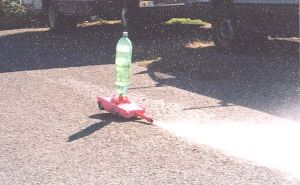
This is what it's all about. Notice the wheelie? This is despite our having to have loaded the car down with 4, apple-sized rocks for stability. That's a lot of weight to be propelling, and somewhat dangerous I suppose, but fortunately we live on a dead-end street.
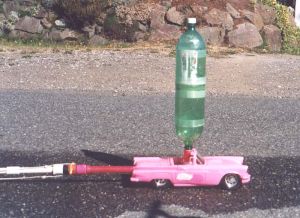
A close up of this stylin' car.
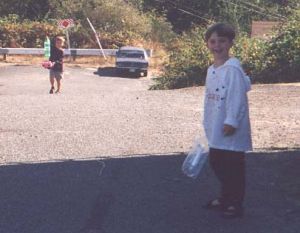
Max, retrieval boy. "Rocket caddy"? He got tired of carrying the rocks.
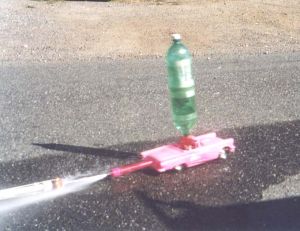
Launch! Still being guided by the stainless steel guide tube extending out of the launch tower.
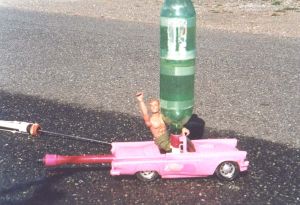
I desperately wanted to send GI Joe on a ride, but my son Max FREAKED when I set him in the car. It was all I could do just to get a photo. Someday when he's at school...
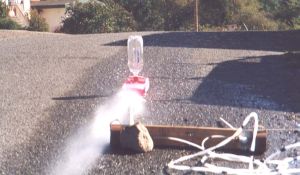
The sheer blast from launching tended to push the launcher back, and after using a foot against the launcher to hold it still and subsequently getting soaked we stuck a big rock there. That worked great.

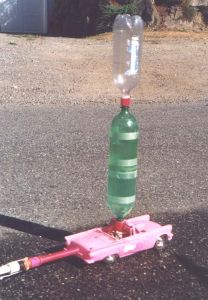
Coupled bottles wasn't such a hot idea, it made the car too top heavy and it teetered and crashed into our RV. But it was a really fun crash. Note the vapor in the top, clear bottle from rapid decompression in the second photo.
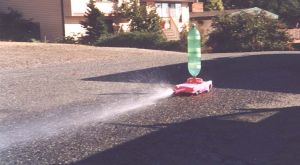
Warp 9. The neighbors loved this by the way.

Naturally you want to try new stuff, so we built a ramp. Then we realized how hard it is to aim the car at the ramp.
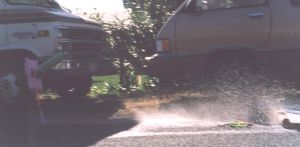
When we finally hit the ramp we realized that the center of effort is pretty far from the center of mass in this thing, and that when airborn, still loaded with water and under power it'll commence to spin. Remember, 4, apple-sized rocks!

Oh the hell with the ramp. This wasn't very successful either, again the mass, effort, entropy, half-life thing.
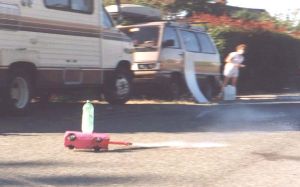
A concerned neighbor Kim looks on.
Epilogue
We arrived at a few conclusions after these "experiments". For one, the laws that apply to normal water rockets don't necessarily apply to rocket cars. Specifically I suspect (without actual scientific measurements) that you can get away with a higher volume of water, maybe even 60%, with a car than you can with a normal rocket and achieve superior speed/distance. Secondly, toy cars modeled after real cars work better than weird funky toy cars. After this first session I retrofitted a Tonka plastic dumptruck, stripped down to its chassis, thinking because of it's oversized wheels that it would handle our relatively rough asphalt street better than the Barbie car. Au contraire mes amis, its short wheelbase and high center of gravity made it crash almost instantly. Let his be a lesson to you SUV owners out there, don't ever attach a giant water rocket to your Ford Expedition!